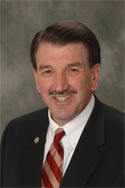By Walter V. Wendler
State Sen. Bill Brady, R-Bloomington, started a discussion with SB1565 that could return the prestige of the higher education enterprise to one of the best in the nation. The not-ready-for-prime-time proposal calls for a conversion of universities to a funding model more like the American Heart Association or the American Cancer Association: not-for-profit organizations intended for public benefit to operate at the direction of a board of directors towards the public good. That sounds like a university to me.
Additionally, Brady’s concept proposes that the current state allocation of $1.2 billion to universities be directed to qualified students to attend institutions of choice, rather than directing appropriations to institutions.
It creates competition and complexities that Adam Smith’s market place will sort out.
This embryonic idea regarding higher education and public benefit parallels the evolution of the GI Bill; legislation that struggled to life, adapted to changing circumstances, and is nearly unanimously regarded as the Petri dish of the American middle class; the success of Kennedy’s loudly proclaimed aspiration to put a man on the moon; and the progenitor of the information revolution through the instigation of modern digital computing.
The GI Bill was hotly debated, and passed through Congress by a single vote. On a warm summer day while the D-Day invasion was at full throttle, Rep. John Gibson of Georgia made his way from his sickbed into the U. S. Capitol to vote “yea” and broke the deadlock, allowing FDR to sign the bill on June 22, 1944. It transformed a nation. The divisions of opinion evidenced in the deliberation of the GI Bill will likewise occur regarding Brady’s proposal.
A brigade of the status quo is already digging trenches in response to Brady’s suggestion. Shamefully, platoons of reactionaries don’t believe the average citizen can grasp the power of the idea. It is daring and challenges the rut-worn road of conventional thought to be sure. Thoughtfully, Brady’s postulation assumes the average Illinoisan, and the families from whom they spring, have the intelligence to make sound educational and economic decisions given the opportunity.
In six short years of experience, slightly more than an average gubernatorial term in our state, the GI Bill of 1944 was subject to significant modification proposed by the VA and the Bureau of the Budget, supported by a number of congressional studies: The original bill sent funding directly to universities but proposals to provide resources directly to qualified students by 1950 subjected the blueprint to a national debate.
It seems that in post-WWII America some universities, and fly-by-night post secondary institutions of every stripe, public and private, were bilking, milking, and sapping the system for personal gain all the while beating veterans out of earned benefits, and taxpayers out of tax dollars. If this doesn’t sound like the current deceptions perpetuated by the likes of Corinthian Colleges, soon to be defunct for bilking, milking and sapping, or the lackluster academic performance of the University of Phoenix, Kaplan, other for-profit, or incompetent not-for-profit providers, even some public institutions, we are myopically not paying attention.
Unscrupulous lenders are involved making loans to students who are unprepared but accepted by universities into too many low value programs — not for their individual or community potential — but for their bulging pockets packed with government loan guarantees. Hard working students who meet the grade deserve a chance, not a mirage fogged by institutionally hyped hope.
Adam Smith’s academic market place, driven by student self-interest, has more state and national value in determining resource flows than institutional interests driven by maintaining “what is” rather than seeking what’s best.
This was the wisdom of the U.S. Congress in evaluating and finally retooling the GI Bill in 1952 that directed government support in the form of educational disbursements to individuals rather than institutions following the second Great War where blood was spilled to protect individual liberty. While in its infancy, Brady’s bill with its nascent ideas has muscular genes. It deserves careful consideration by people inside and outside the education/financial complex.
The status quo in higher education is going to hell in a backpack. Costs to states are too high, students too indebted, degrees of too little value and charlatans too prevalent.
There is a meritorious idea on the table. Illinoisans owe it a serious, no-holds-barred, discussion.




